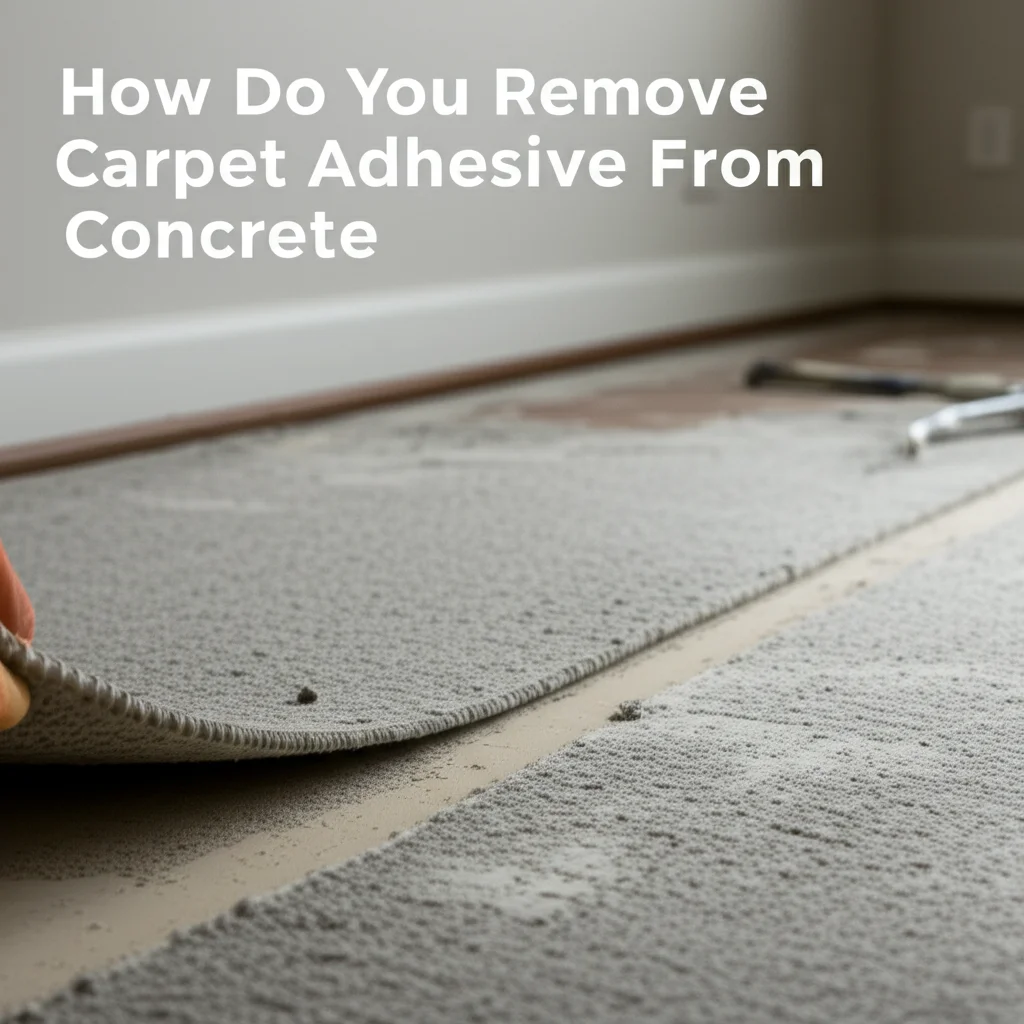· Todd Martin · Home Improvement · 13 min read
How Do You Remove Carpet Adhesive From Concrete

Effortlessly Remove Carpet Adhesive from Concrete
Removing old carpet often leaves behind a sticky, stubborn mess: the adhesive. This sticky residue can be a real headache, especially when it is on a concrete subfloor. You want a clean slate for new flooring, or perhaps you dream of polished concrete.
Tackling carpet adhesive from concrete requires patience and the right approach. It is not a quick job. I have faced this challenge many times, and it is satisfying to see a smooth, clean concrete surface emerge. This article guides you through effective methods to remove carpet adhesive from concrete. We cover everything from essential preparation to specific removal techniques. You will learn about mechanical removal, chemical solutions, and heat application. We also discuss important safety measures and how to clean the concrete floor after the adhesive is gone. Prepare for a satisfying transformation of your floor.
Takeaway
- Prepare Thoroughly: Clear the area, remove carpet remnants, and assess the adhesive type.
- Gather Tools: Have scrapers, heat guns, chemical removers, and safety gear ready.
- Choose a Method: Employ mechanical scraping, chemical dissolution, or heat application, or a combination.
- Prioritize Safety: Always wear protective eyewear, gloves, and a respirator.
- Clean Properly: Finish with a deep clean to remove all residue and prepare the concrete.
To remove carpet adhesive from concrete, you typically scrape off the bulk with a floor scraper, then apply a suitable adhesive remover (chemical or natural) to soften the remaining glue. Heat guns can also soften tough spots. Afterward, you scrub and rinse the concrete to achieve a clean surface, ready for a new floor finish.
Preparing Your Concrete Surface for Adhesive Removal
Before you tackle the sticky residue, proper preparation of your concrete floor is important. A well-prepared area makes the adhesive removal process smoother and more efficient. This step also ensures your safety and protects nearby surfaces. I always start with clearing the space completely.
First, remove all furniture, appliances, and anything else from the room. You need an empty space to work effectively. Next, ensure the old carpet and padding are fully gone. You may have already pulled up the carpet. If not, carefully cut it into manageable strips and pull them up. Sometimes, small pieces of carpet or padding remain stuck to the adhesive. You should remove these by hand or with a strong floor scraper. This initial clean-up exposes the full extent of the adhesive problem. You can then assess what type of adhesive you are dealing with and how much is there. This assessment helps you choose the best removal strategy.
You need to protect any walls or baseboards in the room. Use painter’s tape and plastic sheeting to cover them. This step prevents any chemical removers or debris from damaging these surfaces. Good ventilation is also critical. Open windows and doors. Set up fans to create airflow, especially if you plan to use chemical products. Chemical fumes can be strong and harmful without proper ventilation. This initial groundwork makes the rest of the job much easier. A clean, protected, and well-ventilated workspace sets you up for success. Understanding how to clean a concrete basement floor can provide further insights into preparing concrete for various treatments.
Essential Tools and Safety Gear for Adhesive Removal
Having the right tools and knowing how to use them safely is key to removing carpet adhesive from concrete. This job can be messy and physically demanding. Proper equipment protects you and makes the work more effective. I always gather everything before I start.
Your primary tool will be a floor scraper. Manual scrapers with long handles allow you to stand upright, saving your back. For larger areas or tougher adhesive, consider renting a power floor scraper. These machines significantly reduce the effort and time required. Hand scrapers are useful for edges and corners where larger tools cannot reach. You will also need sturdy utility knives for cutting any remaining carpet pieces. Wire brushes can help scrub off loosened adhesive. A bucket of warm water and dish soap will be useful for general clean-up.
Safety gear is not optional for this project. Adhesive removal can generate dust, fumes, and flying debris. You must protect your eyes with safety glasses or goggles. Wear heavy-duty work gloves to shield your hands from chemicals and sharp tools. A respirator or dust mask is essential, especially when dealing with old adhesive, which might contain asbestos (if installed before the late 1980s). If there is any doubt about the age of the adhesive, you should have it tested. Always work in a well-ventilated area to minimize fume inhalation. Having these tools and following safety protocols ensures you complete the job effectively and without harm.
Mechanical Methods for Stubborn Carpet Adhesive
When carpet adhesive clings stubbornly to concrete, mechanical methods often prove effective. These approaches rely on physical force to scrape, grind, or abrade the glue away. I often start with these methods for thick layers of adhesive.
The most common mechanical method involves scraping. For smaller areas or softer adhesive, a heavy-duty floor scraper with a sharp blade works well. Push the scraper firmly across the concrete, getting underneath the adhesive. You can often peel off large sections this way. For extensive areas or extremely tough adhesive, consider renting a power floor scraper. These machines have rotating blades or hammers that chip away at the glue. They are much faster and less physically demanding than manual scraping. Always keep the blade sharp for optimal performance. Dull blades just glide over the adhesive without removing it.
For adhesive that is truly bonded to the concrete, or if you need a very smooth finish, grinding is the next step. You can rent a concrete grinder equipped with diamond cup wheels. This machine sands down the concrete surface, removing adhesive, thin-sets, and even minor imperfections. It creates a lot of dust, so ensure you have a dust collection system attached to the grinder and wear a high-quality respirator. Grinding is an aggressive method, but it leaves a perfectly clean and profiled surface. This is ideal if you plan to stain, polish, or apply a new coating to the concrete. Be careful not to remove too much concrete. Understanding how to tackle similar challenges, like cleaning paint off concrete, can provide additional insights into mechanical removal techniques for concrete surfaces.
Chemical Solutions: Selecting and Applying Adhesive Removers
Sometimes, mechanical methods alone are not enough to remove carpet adhesive from concrete. That’s when chemical solutions come in handy. These products are designed to dissolve or loosen the adhesive, making it easier to scrape away. I approach chemical use with caution and careful selection.
Chemical adhesive removers fall into several categories. Solvent-based removers are strong and effective, breaking down tough glues quickly. However, they often have strong fumes and require excellent ventilation. Citrus-based removers offer a more eco-friendly option. They work slower but are less toxic and smell better. Always read product labels carefully. Different removers work best on different types of adhesive. Ensure the product you choose is safe for concrete. Test a small, inconspicuous area first. This test confirms the remover works on your adhesive and does not damage the concrete.
Application is key. Most removers require you to pour or spray them onto the adhesive. Allow the product to sit for the recommended dwell time. This lets the chemical penetrate and break down the glue. Dwell times can range from 15 minutes to several hours. During this time, keep the area well-ventilated. Once the adhesive softens, you can easily scrape it off with a hand scraper or a wire brush. You may need multiple applications for very thick or old adhesive. Always follow the manufacturer’s instructions for application, dwell time, and safe disposal. When working with strong chemicals on concrete, understanding how to clean substances like oil from concrete can offer valuable safety and clean-up tips that apply to chemical adhesive removers.
Heat Application Techniques for Softening Glue
Heat can be a surprisingly effective tool for loosening stubborn carpet adhesive from concrete. High temperatures soften the glue, making it easier to scrape away. I find this method works especially well for older, hardened adhesives.
One common way to apply heat is using a heat gun. These tools emit focused, high-temperature air. Hold the heat gun a few inches above the adhesive, moving it slowly back and forth. You will see the glue start to bubble or become gummy. As soon as it softens, immediately scrape it off with a floor scraper. Work in small sections, as the adhesive will re-harden quickly once the heat is removed. Be careful not to overheat the concrete or the adhesive. Overheating can release strong fumes or make the glue even more difficult to remove if it hardens too fast.
Another option is a commercial steam cleaner, particularly one with a floor attachment. Steam penetrates the adhesive, warming it and adding moisture. This combination helps to break the bond with the concrete. Move the steamer slowly over the adhesive, then follow immediately with a scraper. Steam is a good choice for those who prefer to avoid chemicals. It is also effective for adhesives that have absorbed a lot of moisture. Remember to ensure good ventilation when using heat, as some adhesives can release fumes when heated. No matter the method, applying heat strategically can turn a challenging scraping job into a much more manageable task.
Cleaning and Prepping the Concrete After Adhesive Removal
Once you have removed the bulk of the carpet adhesive, your concrete floor will still need a thorough cleaning. This final step removes any lingering residue, prepares the surface for its next finish, and helps prevent future issues. I never skip this part, as a truly clean surface is essential.
First, sweep or vacuum the entire floor to collect all loose adhesive bits and dust. Then, you will need to degrease and clean the concrete. Even after scraping and chemical treatment, a thin film of adhesive or chemical residue can remain. A strong concrete degreaser or a mixture of hot water and heavy-duty detergent works well. Mop the floor with this solution, scrubbing stubborn areas with a stiff-bristled brush. You might need to repeat this process several times to ensure all residue is gone. Rinse the floor thoroughly with clean water. You can use a wet/dry vacuum to remove the dirty water. Allow the concrete to dry completely.
Inspect the floor closely once it is dry. Look for any remaining adhesive spots or stains. If you find any, you may need to apply a small amount of adhesive remover to those specific areas and repeat the scraping and cleaning process. This final cleaning prepares the concrete for whatever comes next, whether it is a new flooring installation, staining, or sealing. A clean, smooth surface ensures proper adhesion for new materials or a beautiful finish for exposed concrete. Learning how to clean stains from concrete can offer additional methods for achieving a spotless surface. For tougher mineral deposits or efflorescence that might appear after deep cleaning, understanding how to clean efflorescence off concrete can also be helpful.
Common Challenges and Troubleshooting Tips
Removing carpet adhesive from concrete can present unique challenges. Sometimes, the glue is incredibly stubborn, or the concrete reacts unexpectedly. I have encountered many tricky situations, and knowing how to troubleshoot saves time and frustration.
One common challenge is extremely old or petrified adhesive. This glue becomes rock-hard and resists most methods. For such cases, combining methods often works best. Start with a chemical remover to soften the glue for an extended period, perhaps overnight if the product allows. Then, use a heavy-duty power scraper or even a concrete grinder to remove the softened adhesive. Another issue is working in cold or hot conditions. Extreme temperatures can affect how adhesive removers work. In cold weather, removers may become less effective. You might need to warm the room slightly. In hot weather, removers can evaporate too quickly. You might need to work in smaller sections or reapply the product more frequently.
Preventing damage to the concrete is also important. Aggressive scraping or grinding can etch or pit the surface. Always start with the least abrasive method. Only escalate to more powerful tools if necessary. If you are using a grinder, use fine-grit pads and move slowly to avoid damage. Excessive use of water can also be a problem. While rinsing is necessary, standing water can lead to issues like mold if not dried properly. Ensure proper ventilation and drying after wet cleaning. If you face persistent issues like moisture or staining, knowing how to tackle problems such as cleaning mold off concrete can offer related solutions for maintaining your concrete floor’s integrity. Patience and a willingness to adjust your approach based on the adhesive’s behavior are your best assets for successful removal.
Frequently Asked Questions
Can I use a pressure washer to remove carpet adhesive from concrete?
Using a pressure washer can remove loose adhesive, but it might not be effective for deeply bonded glue. High pressure can also damage concrete, especially older or weaker slabs. It can also force water deep into the concrete, leading to moisture problems later. It is generally not the recommended primary method.
How long does it take to remove carpet adhesive from concrete?
The time varies greatly based on the adhesive type, its age, the size of the area, and the removal method chosen. A small room with soft adhesive might take a few hours. A large area with old, tough glue can take several days or even longer for a do-it-yourself project. Patience is key.
What if some adhesive remains after cleaning?
If small patches of adhesive remain, you can spot-treat them. Apply a small amount of chemical remover directly to the stubborn areas. Let it sit, then scrape and clean. For minor haze, a concrete degreaser or a light sanding with a floor buffer might be enough to achieve a completely clean surface.
Is it necessary to seal concrete after removing adhesive?
Sealing the concrete after adhesive removal is not always necessary, but it is highly recommended. A sealer protects the concrete from stains, moisture, and wear. It also makes future cleaning easier. The choice of sealer depends on your concrete’s final use, such as a topcoat or a new flooring base.
Are there natural ways to remove carpet adhesive from concrete?
Yes, some natural methods exist. Hot water can soften water-soluble adhesives. Vinegar and baking soda can also help break down some glues, especially older ones. Citrus-based removers are also considered more natural alternatives to strong solvents. These methods are generally less aggressive but may require more time and effort.
What’s the difference between carpet glue and carpet adhesive?
The terms “carpet glue” and “carpet adhesive” are often used interchangeably. Both refer to the material used to bond carpet to the subfloor. Historically, glue referred to natural, water-based products, while adhesive was a broader term for stronger, synthetic bonding agents. Today, they effectively mean the same thing in common usage.
Conclusion
Successfully removing carpet adhesive from concrete transforms your space and prepares it for its next chapter. While it might seem like a daunting task, approaching it methodically makes it manageable. We explored crucial steps from thorough preparation to the selection of appropriate tools and safety gear. You learned about effective mechanical methods like scraping and grinding for stubborn spots, as well as the power of chemical solutions and heat application.
Remember, a clean concrete surface is within reach. Always prioritize safety, test products in small areas, and be patient with the process. The effort you put into thoroughly removing carpet adhesive from concrete will result in a perfectly clean and smooth floor, ready for any new flooring or finish you envision. Take on this project with confidence. Your concrete floor is waiting to be revealed and renewed.
- carpet adhesive removal
- concrete floor prep
- glue removal
- flooring DIY
- adhesive cleaner
- concrete cleaning
- home renovation





